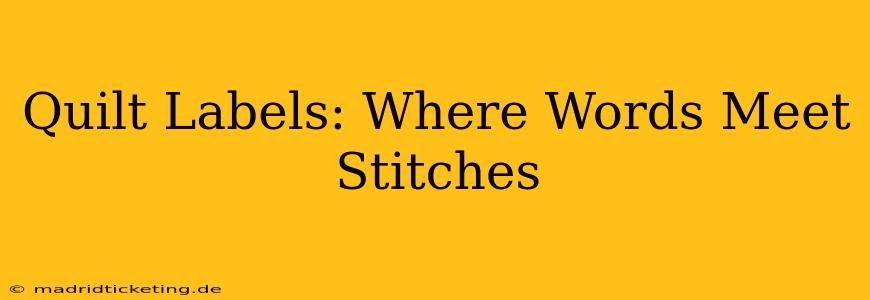Quilt labels. Those small, often overlooked squares of fabric hold a wealth of information and sentimentality. They're more than just identifying tags; they're miniature time capsules, preserving memories and stories woven into every stitch of the quilt itself. From simple handwritten notes to intricate embroidered designs, quilt labels offer a glimpse into the quilter's craft, the recipient's history, and the enduring legacy of handmade artistry. This comprehensive guide will explore everything you need to know about quilt labels, from their history and purpose to design ideas and practical application.
Why Are Quilt Labels Important?
Quilt labels serve several crucial purposes, going far beyond simply identifying the quilt's maker. They act as:
- A Record of Creation: Labels document who made the quilt, when it was made, and often, who it was made for. This information becomes invaluable as quilts are passed down through generations.
- A Keepsake of Memories: Quilt labels can include personal touches like dates of important events, names of family members, or even a short message from the quilter to the recipient.
- A Mark of Authenticity: In the world of antique quilts or heirloom pieces, a well-preserved label significantly contributes to its provenance and value.
- A Source of Inspiration: Examining various quilt labels can inspire new design ideas and techniques, enriching the quilter's own creative journey.
- A Piece of History: Collectively, quilt labels offer a unique perspective on quilting traditions, techniques, and the societal context in which they were created.
What Information Should I Include on My Quilt Label?
The information you include on your quilt label is entirely up to you, but here are some common and helpful elements:
- Quilter's Name: The name of the person who made the quilt.
- Date Completed: The date the quilt was finished.
- Recipient's Name (if applicable): The name of the person the quilt was made for.
- Pattern Name (if known): The name of the quilting pattern used.
- Fabric Type (optional): A brief description of the fabrics used, such as cotton, flannel, or a specific blend.
- Special Occasion (optional): The occasion the quilt was made for (e.g., wedding, baby shower, birthday).
- A Personal Message (optional): A short message from the quilter to the recipient, expressing love, well wishes, or memories.
What Different Types of Quilt Labels Exist?
There's a vast world of quilt label designs, each offering a unique aesthetic and level of complexity. Some popular options include:
- Simple Handwritten Labels: These are quick, easy, and allow for personal touches. They often involve a small piece of fabric with the essential information written neatly in ink.
- Printed Labels: You can design your label on a computer and have it printed on fabric using an inkjet printer or heat transfer method. This option allows for intricate designs and precise text.
- Embroidered Labels: Embroidered labels add a touch of elegance and sophistication. They can incorporate the quilter's initials, a small design, or even the full information meticulously stitched onto the fabric.
- Appliqué Labels: Appliqué labels involve cutting out fabric shapes and sewing them onto a background fabric. This offers a unique visual appeal and allows for creative freedom in design.
How Do I Attach a Quilt Label to My Quilt?
Attaching the label securely is crucial to preserving the information it contains. Here are a few techniques:
- Hand Sewing: This is the traditional method, offering a secure and discreet finish. Use a small, neat stitch to attach the label to the quilt's backing, ensuring it lies flat.
- Machine Sewing: A machine can quickly and efficiently attach the label, but be mindful of stitch tension to avoid puckering or distortion.
- Appliqué Technique: If the label is an appliqué, the method of attachment is integrated into the design itself.
What Materials Should I Use for My Quilt Label?
The choice of fabric for your quilt label depends on your preference and the overall style of the quilt. However, it's recommended to use a durable fabric that will withstand the test of time, such as:
- Cotton: A classic choice, cotton is readily available, easy to work with, and holds ink well.
- Linen: A slightly more luxurious option, linen offers a subtle texture and elegant look.
Remember to use fabric that complements the overall aesthetic of your quilt.
Where Should I Place My Quilt Label?
The ideal placement for your quilt label is on the quilt's lower right corner on the back. This location is generally out of sight but easily accessible when needed.
This comprehensive guide provides a foundation for understanding the importance and creation of quilt labels. Remember, your quilt label is a personal expression that adds depth and meaning to your handcrafted creation. Let your creativity shine and capture the story behind your stitches!

